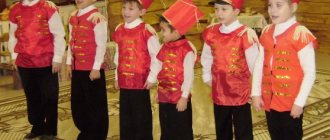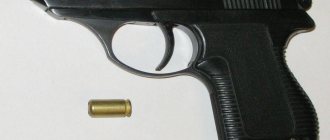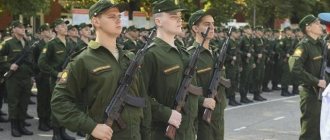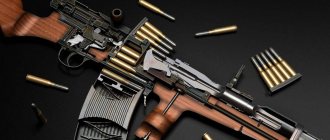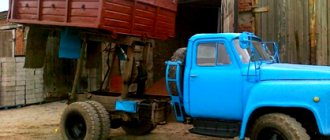Traditional Ukrainian men's suits have considerable similarities with other East Slavic clothing. They are based on shirts made from hemp or linen, as well as woolen or cloth pants. Shirts worn over the body often served as outerwear. A distinctive feature of men's Ukrainian shirts is the presence of a front slit (sinus), decorated with embroidery.
Structurally, shirt collars can be standing, with turn-down collars or without collars. In such cases, shirts are assembled in ruffles and trimmed with braid or narrow strips of fabric. In this way, low standing collars are obtained, which are sewn to the collar of the shirt from the bottom. Ukrainian men's clothing also had wide turn-down collars.
Shirts are buttoned or tied at the collar with buttons or ribbons. Men wear shirts tucked into their pants. In the cut of their shirts, all East Slavic peoples made inserts in the armpit area with three- and four-cornered pieces of material. The shoulders of Ukrainian shirts were decorated with stripes such as shoulder straps or embroidered inserts - “setpoints”.
Ukrainian folk costume
The pants were secured to the body with laces or belts that were worn with buckles. Cossack trousers were very wide. Rectangular pieces of fabric with a rhomboid sewn underneath were sewn between the legs; they were so wide that they resembled the shape of a bag. The material for the pants was canvas or cloth.
Ukrainian women's folk costume had many local variations. The peculiarities of ethnography in the historical and cultural regions of Ukraine were reflected in clothing, cut, some elements of traditional clothing, ways of wearing it, colors, decor, and jewelry.
Modern interpretation
While maintaining the main trends of folk costume, modern fashion designers offer new images that are incredibly luxurious and original. Vibrant colors and distinctive decorations effectively intertwine tradition and modern trends.
DIY ant costume for a boy
How to choose a tie for a suit and shirt
Distribution of traditional outfits by regions of Ukraine
The main differences between traditional outfits that are presented in Ukraine can be considered:
- The archaic nature of clothing elements was preserved most of all in the Polesie regions;
- Classic Ukrainian clothing could be found in the Middle Dnieper region;
- In the south, the influence of traditional costumes of different peoples was encountered;
- In Podolia, ethnocultural ties between Ukrainians and Moldovans were noted;
- In the northwest there was a connection with Poland;
- Ukrainian highlanders wore special and colorful clothes.
Be that as it may, ethnographers attribute the traditional clothing of Ukrainians, as fully developed, to the 16th-18th centuries.
The most common traditional Ukrainian costumes were in the Middle Dnieper region, as well as a little in Polesie, Slobozhanshchina and Podolia. The outerwear of men and women was similar in cut. The basis of Ukrainian women's costumes were shirts - koshuls, shirts. They were longer than men's shirts and included two parts, with the lower one sewn from coarser fabrics.
The highlanders, Boykos and Lemkos also had shirts in two parts, each of which was worn separately. There were also one-piece shirts; in fact, they were for women as elegant and festive ones. Based on the cut, the shirts were tunic-shaped, poly-shirted, and also had a yoke.
Shirts could be made with or without collars. These types of shirts were considered more ancient. Their gates were usually assembled into small assemblies, and sometimes sheathed on top. Shirts with collars were called Polish. A so-called conventional line was drawn across the territory of Ukraine between two types of shirts. So, in the eastern regions they were without collars, and in the western regions they had collars, more often turn-down.
A distinctive feature of Ukrainian women's shirts was the decoration of the hem and border of the shirts with embroidery, visible under the outer clothing. In addition, there were decorations on the sleeves of shirts, especially where the sleeve connected to the shoulder. The wide sleeves of the shirts had endings in the form of cuffs at the wrists.
Decorations
Women decorated themselves with glass beads and dukachi , and Ukrainian men also loved jewelry. Cossacks wore crescent-shaped earring And among the Hutsuls, silver or bronze bracelets and rings . In addition, they fastened the collars of their shirts with a metal cufflink . The accessory to the festive costume of the Cossacks was a club , and the Hutsuls - a hatchet .
Features of waist clothing
According to ancient customs, East Slavic girls up to the age of fifteen or before marriage had to have belted shirts. The ritual of putting on waist garments (ponev) was associated with marriage, after which the girls became women. Ponevs were common Slavic elements in traditional clothes that covered the body from behind and were fastened at the waist.
Ukrainians had three types of such clothing:
- Everyday ones without patterns - spare tires;
- Derg;
- Festive outfits with large checks - scaffolds.
Dergs are three long panels sewn together, forming a strip of fabric three meters wide and up to three quarters long. They covered the women's bodies from behind and were tied with a belt. Since dergs were considered everyday wear, they were made from black or undyed fabrics, without decorations.
Spare wheels differed from dergas in that they had ribbons at the top corners that were tied at the waist. Usually two spare tires were worn, usually in different colors. One covered the body from behind, the other, worn in front, was used as an apron. Spare parts were made from high-quality and thin woolen and plain fabrics. They were blue, green and also red.
Plakhta as festive clothing were made from fabrics with a checkered pattern. They were embroidered by hand. Woolen or silk scaffolds are known. In the early periods, scaffolds were made from gold and silver brocades.
Skirts are considered a further evolution of ponev. Thus, in the Polesie region, such woolen skirts with striped patterns - andaraki - were widespread. In addition to women's costumes, there were breast decorations. The material for them could be precious stones, glass, beads, as well as coins of the “monista” or “dukach” type.
Materials used
Previously, the Ukrainian national costume was made exclusively from natural materials. When sewing it, hemp fabric was used, as well as wool and linen. Cheap, often homespun, materials were used to sew items intended for everyday wear. The rich and nobles preferred products made from brocade, satin, velvet and silk. They were decorated with silver or gold threads.
Nowadays, when sewing such suits, not only natural material is used. The use of synthetic fabrics is also appropriate. The embroidered patterns are created even more intricate and lush than in the case of traditional clothing.
Modern wardrobe items made in traditional style look as luxurious as those used many centuries ago.
Particular attention is paid to accessories. They are presented in a huge variety. They are traditionally made using stones, wood and glass, but more modern materials can also be used. The main thing is that they harmonize with the outfit and are visually similar to ethnic jewelry.
Ukrainian outerwear
There was variety in Ukrainian outerwear related to cut and names.
The history of fashion identifies four types of such clothing:
- Straight-back type of raincoats, shirts or robes. The cloaks were chugs, chugai, chugani, which were common among Westerners. The chugs barely fit over the shoulders and were not worn in the sleeves. The sleeves themselves were sometimes sewn up at the bottom. Thus, they were used as pockets or bags;
- The shapes of manta or gugli cloaks among the Hutsuls resembled large bags, open on one long side. The hood was the bottom of the bag, which was secured to the shoulders using special laces. At the beginning of the 20th century, manti served only as ritual clothing for brides during weddings;
- Robe-like clothing included kobenyaki, kirei, and siryak. They wore retinues with kobenyaks. The stubby retinues were worn on top of fur coats, and were made from cloth, mainly in gray colors. The hoods of vidloga, kokbok, kaptur, beard, shanka, and virgin sewn to them had the shape of bags with a rounded bottom and holes for the eyes;
- Widespread cuts of outerwear among Ukrainians were wedge-shaped silhouettes. Thus, wedges were sewn in behind the sides below the waist. The sharp ends of the wedges reached the waist, and the bases were in the hem area. Retinues, siraki, kutzinki and guni were sewn using the same patterns;
- Outerwear cut off at the waist. In this case, the lower parts were gathered into large folds or small gathers, after which they were sewn to the upper parts. This is how retinues, kozhushins (fur coats), and kirsets—women's jackets without sleeves—were sewn.
In the latter case, the gathers were made along the entire waist. These types of clothing were chemers, chemerki, chamarkas.
A belt was considered one of the obligatory attributes in the clothing of the Ukrainian people. According to East Slavic mythology, belts acted as amulets; they protected the body. Three- and four-meter belts were wrapped around the waist several times, and the ends ending in tassels were let below the knees. At one time, Persian silk belts were popular, and brides were girded with embroidered towels - towels.
Ukrainian headdresses
The headdresses of Ukrainian men were very diverse. This was reflected in the forms, materials and names. Popular shapes were cones, cylinders, and also semicircles. There were fur, wool, and cloth headdresses. For example, there were tall lambskin hats (kuchmas), winter hats with elongated earmuffs (triukhi, malakhai), felt and straw hats (bryl). At the end of the 19th century, caps and caps began to be worn, which became widespread.
There was also a great variety in women's hats, including their purpose. One of the most popular headdresses used by married women was a four-cornered scarf. It takes its historical beginning from head coverings - long cloths that were tied at the back, letting the edges run down the back. Similar headdresses have been preserved in western Ukraine. In their simplest forms, headdresses such as kibalkas, khomevkas, and khomleys looked like hoops or arches facing backwards. Women curled their hair on them. Kibalki served as a frame for upper headdresses.
Simplified versions of Ukrainian women's headdresses were soft, lightweight hats (ochipkas, bonnets, bonnets), which were tied with laces pulled through the hems. Caps were sewn from pieces of thin fabric of different colors with a transverse undercut on the forehead. The undercuts were made in such a way that something like small gatherings were formed above the forehead, while the material on the forehead remained smooth. Scars were formed on the backs of the heads, through which laces were threaded. Festive caps were made of gold or silver brocade.
World-famous at all times, girlish wreaths made of artificial and fresh flowers with ribbons were very popular in Ukraine. There were no requirements for covering the head and braid for such girls' headdresses. By the way, braids were the main hairstyles of Ukrainian girls. The girls braided their hair in one or two braids, wrapped it around their heads and tied them with colorful headbands decorated with beads.
Shoes of the Ukrainian people
The shoes of the Ukrainian people for both sexes were made of leather. At first they did not sew it together, but folded it, tried to wrinkle it, and then tied it to the legs with long ropes. Hence their name - morschuns, morshchentsy, postols, hodak. The leather shoes with high tops had no heels. Sometimes heels were replaced with small iron shoes on the heels.
Since the middle of the 19th century, special boots, the so-called reversible shoes, prevailed. The soles were sewn to the inside of the boots, and the boots were completely wetted with water and turned inside out.
Symbolism of Ukrainian folk costumes
Any ritual symbolism of costumes reflected the spiritual traditions of the people, as well as their worldview and ritual norms. Such ritual symbols included some elements of clothing. These could be scarves or towels during the matchmaking process, white or black scarves, etc. They were assigned the role of protectors of people from dark forces and a way to attract prosperity, health and love.
It was believed that special magical powers were possessed by objects made with one’s own hands for certain rituals. For example, girls had to sew embroidered shirts for their grooms. Indispensable gifts also had symbolic significance, for example, boots made by the son-in-law for the mother-in-law.
Ritual functions, in addition to the style of clothing, were manifested in a certain specificity. For example, in some rituals clothes were worn inside out, which in everyday life was considered a bad omen. In some rituals, cross-dressing occurred.
Ritual symbols can often be found in the colors of outfits. From time immemorial, red colors have dominated wedding dresses. While funeral clothes were distinguished by black colors, which were one of the symbols of sadness in most areas of the late 19th and early 20th centuries, replacing white, and in some places blue.
Traditional embroidery of the Ukrainian people
Ukrainian embroidery is considered one of the pride items in folk art. It was often used both in folk costumes and in everyday life. Embroidery in Ukrainian dresses was distinguished by its richness and variety. It was used to decorate men's and women's shirts, outerwear, and headdresses.
Ornaments, compositional motifs, colors, and traditions were passed down from generation to generation. The ornaments were dominated by geometric shapes such as rhombuses, rosettes, stars, as well as plants. There were many embroidery technologies and their varieties. There were also many ancient types in folk embroidery. One of the variations in such techniques is satin stitch embroidery, which was quite popular in Ukraine at that time.
The color scheme of embroidery on Ukrainian shirts included single-color, two-color, and polychrome. The first such shirts were typical for the Poles, as well as the population of the Chernigov and Poltava regions. Two-colored ones were mainly used by residents of the Kyiv region and Podolia. Polychrome ones were used by Ukrainians in Western Podolia, as well as in the Carpathians.
In the embroidery of the northern regions of Ukraine, a predominance of red color was observed. In the central regions of Ukraine, in addition to red, one could find black colors. The southern regions also added yellow to these universally popular colors. Red and black combinations were often found in Podolia embroidery. In the regions that bordered Bessarabia and Bukovina, one could find embroidery enriched with beads and metal decorations, which brought it closer to Moldavian and South Slavic ones.
Ukrainian artistic weaving was engaged in the extensive development of plant ornaments. Moreover, the most favorite motifs were fabrics decorated with patterns depicting branchy flowers or trees. Such motifs were typical both in towels made of homespun white material and in carpet weaving, which was widespread in many regions of Ukraine, but most of all in the central and eastern regions.
At the end of the 19th and beginning of the 20th centuries, the Ukrainian people preferred to switch to urban clothing. As a result of “cultivation” and the general transition to “civilized” costumes, many features of national traditional outfits were lost.
LiveInternetLiveInternet
Eastern Polesie
. The end of the 19th - the beginning of the 20th centuries. Wedding outfit of newlyweds of the former Novgorod-Seversky district of the Chernigov province, now Novgorod-Seversky district of the Chernigov region
The wedding attire of the young people of Chernigov Polesie (northern region of Left Bank Ukraine) was at the end of the 19th - beginning of the 20th centuries. a fairly well-established complex of traditional costume, characteristic of Ukrainians across a wide area of the eastern and central forest-steppe regions of Ukraine. At the same time, this complex, especially the embroidered elements of the upper female and male attire, had many common features with similar forms of clothing of Belarusians and Russians from areas that border Ukraine. Over an embroidered wedding shirt, the young woman is dressed in a peculiar sleeveless dress, so called. “skirt with bib”, cut off at the waist and widened at the bottom. The apron is embroidered with colored silk. In the hands of a young wedding scarf. On her head is a wedding wreath made of wool pompoms. Over the wedding shirt with an embroidered stand-up collar and bosom, the young man has an embroidered vest and a chumarka made of kupovan fabric. The pants are belted with a woven belt. The merlushka hat is decorated with a wedding red ribbon. “Sorry for the translation, translated with the help of a translator”
Eastern Polesie
.
The end of the 19th - the beginning of the 20th centuries. Wedding attire of the newlyweds of the former Gorodnyansky district of the Chernigov province, now the Shchorsk district of the Chernigov region The wedding attire of the inhabitants of Chernigov Polesie (the northern region of Left Bank Ukraine) at the end of the 19th - at the beginning of the 20th century constituted a fairly well-established complex of the traditional costume of Ukrainians of a wide area of eastern and central forest-steppe regions of Ukraine. A gray retinue made of homemade cloth is young around the edges, on the flaps, at the neck and on the cuffs, decorated with black velvet, colored braid and patterned machine stitching. The embroidered division of the wedding shirt appears under the red skirt. Over the skirt is an apron lavishly decorated with woven lace and embroidery. On his feet are handmade boots. Young, instead of a colored belt, belted with a woven wedding towel. The young woman's head was decorated with flowers - a kind of wedding wreath, from which colored ribbons of different colors fall .
The wedding shirt of the young man is decorated with embroidery on the stand-up collar, bosom and cuffs. The blue color of the wide trousers, belted with a red woven belt, contrasts with the white retinue, decorated, like the young ones, with black velvet. A red ribbon is attached to the chest - the distinction of a young man, and a wedding wreath is attached to the merlushka hat.
Added after 9 minutes Central Polesie. End of the 19th century Wedding attire of newlyweds from the former Chernobyl district of the Kyiv province, now the Chernobyl district of the Kyiv region. The wedding attire emphasizes the advantage of white with minor color accents of red and green.
Western Polesie.
The end of the 19th - the beginning of the 20th centuries. Wedding attire of newlyweds in the former Rivne district of the Volyn province, now the Dubrovitsky district of the Rivne region. The wedding attire is distinguished by its local white color, the almost complete absence of colored decorations and various additions that enriched the wedding clothing of other regions of Ukraine at the end of the 19th - beginning of the 20th century. The wedding maiden shirt was made from finely stranded white, so called. “smoky” linen fabric. A smoky white apron was worn over the shirt. On the left side of the chest, a wedding flower made of three periwinkle leaves tied with white thread was attached. The legs were wrapped in onuchas made of bleached linen and put on bast shoes woven from oak “strip”. Bast shoes were attached to the feet with laces made of flax or hemp - “ruffles”. The young chairman was decorated with a smoky basting with “curled” edges, wrapping it around the chairman like a girl’s scarf, leaving the back of his head open. A periwinkle wreath was placed on top. In her hands the young woman held a wedding “klummka” with gifts: baked “trepetushki”, “kalachiki”, pumpkin seeds. The young man’s outfit was also extremely modest. The wedding shirt that the bride gave her was made of thick “tow” white or gray linen. The shirt was sewn with a narrow stand-up collar and a bosom. The sleeves were gathered at the cuffs. The shirt was worn untucked over tight pants made of gray unkempt flax, so called. "nonsense." The only color accent was a woven wide striped belt - “poromka” - with a large number of multi-colored small pompoms - “mokhriv”. On the left side of the chest of the young man, like the younger ones, a wedding flower was tied. Woven bast shoes were put on the feet on linen onuchi.
Added after 11 minutes Western Polesie.
The end of the 19th - the beginning of the 20th centuries. Wedding attire of the newlyweds of the former Pinsk district of the Minsk province, now the Lyubeshovsky district of the Volyn region The wedding attire, like the entire complex, is traditionally the everyday culture of the population of the extreme northern regions of the modern Volyn region, which borders on Belarus, for a number of signs it reveals commonality with the traditional culture of Belarus. The wedding attire of the young people of Volyn Polesie is marked by the contrasting highlight of the bright red and black colors of woven ornamental patterns against the background of bleached linen. A young woven wedding shirt with a turn-down collar and a woven overlay has wide sleeves fully woven in red and black, gathered near the cuff. A woven skirt and apron were worn over the shirt. The neck is decorated with several rows of necklaces. On the feet are onuchi made from the old woven shirt and bast shoes. The young headdress is unique - a white woven basting with patterned tangled ends. On top of the basting they put on a wedding crown in the form of a solid high hoop, widened at the top, trimmed with colored ribbons, pre-folded. It was worn tilted on the right side, and at the ends there were lush pinches of a multi-colored feather, which was supposed to turn away bad forces from the young woman. On graduation, the young man wore a white linen wedding shirt, which was given to him by his bride, over narrow trousers made of homespun linen. The turn-down collar and bosom were also decorated with embroidery. They belted the young man with a woven fire belt. The friend's straw hat was decorated with a wedding wreath and a flower made of colored, mostly red, ribbon. On the legs there are onuchi and bast shoes, which are tied with hemp woven laces - “frills”.
Slobozhanshchina
.
The end of the 19th - the beginning of the 20th centuries. Wedding attire of the newlyweds of the former Starobelsky district of the Kharkov province, now the Starobelsky district of the Voroshilovgrad region The basis of the bride’s wedding attire in the suburban lands of Ukraine was a wedding shirt, decorated along the lower edge with woven lace. A rich skirt made of wool, calico or silk was worn over the shirt. The front of the skirt was covered with a colored apron, the bottom was trimmed with fringe, and the lower part was decorated with stripes of multi-colored lace and jagged ribbons of mostly dark colors. The typical outer festive clothing of young people in these areas was a corset made of fine wool, cloth or velvet with sleeves, the so-called. "skirt", "kutsina". The skirt was decorated with multi-colored laces, piping, ribbons, lace nets, braids and shiny metal buttons. The bride's head was tied with a silk, mostly white, cloth or scarf, a wedding wreath of artificial flowers was placed on top, and a peacock feather was inserted into the wreath on the left side. The newlyweds were required to tie a wedding towel instead of a belt. On his feet are colored morocco boots. The neck was decorated with threads of beads, amber, and corals. The young man was wearing a sleeveless vest over his wedding embroidered shirt. The pants were sewn from the factory, the so-called. "Swedish" fabric. The young sister sewed a round flower onto the brow. A lightweight festive retinue, the so-called, was thrown over the shoulders. “chumarka”, “chinarka” are made from purchased cotton fabrics, and in the more prosperous - from thin factory cloth. The front flaps and collar of the chumarka were decorated with shiny metal buttons and embroidered with multi-colored silk. Southern Poltava region
.
The end of the 19th - the beginning of the 20th centuries. Wedding attire of the newlyweds of the former Kobelyaksky district of the Poltava province, now Kobelyaksky district of the Poltava region In the wedding attire of the young southern regions of the Poltava region, preference was given to elements sewn from purchased fabrics. Only the shirts of the bride and groom, the bridegroom’s belt and the wedding towel that the bride tied up with them were made by hand. Over the wedding shirt, richly embroidered on the sleeves and at the bottom, is worn a sleeveless vest made of colored chintz. An apron made of brocade is put on a rich skirt, sewn from purchased woolen fabric, and an embroidered towel is placed on top of it. The head is decorated with a lush wedding wreath and colored ribbons, and the neck is decorated with a necklace, ducats, and corals. A Chumarka is thrown over the wedding shirt over the shoulders of the young man. A woven wool belt girds the waist over wide trousers tucked into boots. On the head of the young man is a lambskin hat, decorated with flowers and a wedding corolla, and his chest is decorated with a wedding flower and ribbon. Added after 6 minutes Northern Poltava region
.
The end of the 19th - the beginning of the 20th century. Wedding attire of the newlyweds of the former Mirgorod district of the Poltava province, now Mirgorod district of the Poltava region Wedding attire of the young people of the Poltava region of the late 19th - early 20th centuries. absorbed the best elements of the festive mood of the Ukrainians of the forest-steppe regions of the central Dnieper and Left Bank regions and became a kind of symbol of national Ukrainian clothing. The basis of the wedding cut was a linen shirt with white thread embroidery on a white linen in combination with such technical means of openwork decor as pricking, cutting and mesh. A scaffold was put on over the shirt, and an apron (“spare tire”) was put on top of it. The condition of the young woman was shown with a wedding embroidered towel, garus. A kerset, sewn from purchased fabric and decorated with an applique of cloth or velvet, was put on the shoulders, over which wealthy peasants threw a casing. The head was decorated with a wedding girl’s scarf with horns from lessons and a wreath, and the neck was decorated with a significant number of necklace threads, corals and ducats. The young man is dressed in a white shirt from homemade cloth, decorated with velvet, blue wide pants, and boots. The narrow collar of the wedding shirt is tied with a red wedding ribbon, and the lambskin hat is decorated with a wedding corolla and ribbon. Added after 5 minutes Southern Kiev region.
The end of the 19th - the beginning of the 20th century.
Wedding attire of the newlyweds of the former Chigirinsky district of the Kiev province, now the Chigirinsky district of the Cherkasy region The main element of the wedding dress of the bride in the southern regions of the Kyiv region, as elsewhere in Ukraine, was an embroidered shirt. At the end of the 19th - beginning of the 20th century, the traditional geometric composition of embroidery was replaced by plant compositions in the southern regions of the Kiev region. The advantage in embroidered wedding shirts was given by the red color, which, according to ancient ideas, had magical powers - it protected against the evil eye. Over the shirt they put on a skirt sewn from purchased fabric, which covered the traditional woven blanket in the Kiev region at the end of the 19th century. An apron (“spare tire”) was sewn from a single-color cloth (mostly red in young women), which was worn over the skirt. The so-called young woman was considered a very solemn element of the festive attire. “Yupka” is a kind of hat with long or short sleeves so that the embroidered sleeves of the shirt can be seen. The yupka was made from green cloth and decorated all over with small tails of red woolen yarn. It was a kind of folk version of the royal robe made of ermine fur. On her feet are red morocco boots. An obligatory ritual element was a young girl's wedding attire. In her hands the girl was holding a wedding towel she had embroidered, which she used instead of a belt. The groom's outfits were more restrained regarding the number of elements and their colorfulness. It was based on an embroidered young wedding shirt, the obligatory wedding attribute of which was a “clasp” (silk ribbon or woolen cord) of ritual red color. Festive pants were made from store-bought fabric. The sign of the groom was a wedding scarf, which the bride inserted into his belt. Outerwear was a traditional retinue or poddevka. The young man's head was adorned with a tall, cylindrical gray lambskin cap. The senior friend sewed a wedding corolla to the hat - a bouquet of periwinkle, cornflowers and three ears of rye, tied with a red ribbon. On his feet are handmade welt boots. Added after 6 minutes Eastern Podolia
.
The end of the 19th - the beginning of the 20th century. Wedding attire of the newlyweds of the former Kamenets-Podolsk district of the Podolsk province, now the Kamenets-Podolsk district of the Khmelnytsky region. The uniqueness of the wedding attire lies in the presence of a woven skirt (“humpback”). One end of the humpback was bent, securing it to the belt. The belt (“edge”) was woven from colored wool, predominantly red. A wedding shirt should always be made from a single piece of fabric from top to bottom. According to folk tradition, it was believed that if the shirt is whole, then life should be “whole”, “full”. When preparing the shirt before the wedding, the young woman decorated it with embroidered patterns, mostly geometric, which were made with the favorite black color in Podolia, a kind of seam, the so-called. "low", "low". They embroidered ornamental stripes on the bosom, and also made hemstitching and sewed the hem of the shirt. The neck and chest of the young woman were decorated with numerous threads of beads and corals, which served as amulets - against the evil eye and evil spirits. The bride and groom are dressed in traditional Podolsk retinues, decorated with colored laces, cloth and braid with cuffs (“zakavrashami”). The young woman's head is decorated with tiaras and a wreath of periwinkle leaves and artificial flowers. A wedding wreath was also placed on the bridegroom's hat. The young man's neck is tied with a wedding silk scarf. Added after 6 minutes Bukovyna
.
The end of the 19th - the beginning of the 20th century. Wedding outfit of the newlyweds of the former Kitsmansky district of Bukovina, now the Kitsmansky district of the Chernivtsi region. A one-piece long wedding shirt of the young man has densely embroidered sleeves with characteristic stripes (“odd jumps”). The color scheme of the embroidery on the shirt is dominated by black and burgundy, contrasting with other multi-colored elements of the young woman’s outfit. The condition from the waist down is shrouded in opinka (“veil”), characteristic of this zone of Ukraine, with wide horizontal purple and narrow white stripes. Colorful wedding scarves with threads are lowered symmetrically from both sides of the belt to the bottom. The uniqueness of girls' clothing was provided by a long-skirted fur vest made of bleached sheepskin and trimmed along the bottom, along the shelves, around the armholes with ferret fur - the so-called. “muntyan”, “mentyan”, “tsurkanka”. It was also decorated with appliques made of colored morocco, cloth, leather and wool laces, embroidery, and colored wool. Particular attention was paid to the quantity and quality of neck jewelry, which had a symbolic meaning - to ensure a rich and happy future in life for the young - the more jewelry there was, the greater the imaginary confidence in the wealth of the future family. Wedding attire of the young people of the former Kitsmansky district of Bukovina Jewelry was made by sewing coins onto a fabric base, thereby creating a kind of removable coin bib. The bride’s headdress is also unique – “karabulya”, “koda”. Colored ribbons - “codes”, “kodinki” - were attached to the back of the carabul. The originality of the men's suit was provided by an outer robe-like made of white homemade cloth, straight-cut bisexual clothing with wide sleeves, the so-called. "manta". On the chest on the left side, over the manta, the young friend clung a wedding scarf - a “fly”. On the young man's head is a wide-brimmed straw hat, lavishly decorated with beaded stitches - gerdan, feathers, etc. “shakers”, “beaters”. On his feet are boots with high tops. Added after 10 minutes Pokuttya Gorodenkovskoe.
The end of the 19th - the beginning of the 20th century.
Wedding outfit of newlyweds of the former Gorodenkovsky district of Galicia, now Gorodenkovsky district of the Ivano-Frankivsk region. Wedding maiden one-piece shirt, the so-called. "Rukav'yanka", "Rukav'enka", with the characteristic placement of ornamental embroidery, rich in color and technique of execution of festive shirts. A one-piece woolen skirt woven in multi-colored stripes, the so-called. “opinka”, “wrapper”, and woven apron (“reserve”) are finely corrugated. Both ends of the hem are picked up and attached at the waist line with a wide woolen belt - an “edge”, the ends of which are lowered in front over the spare tire. The edge at the top is tied with a narrow woven belt - a “band”, the ends of which are also lowered in front over the ends of the edge. The neck and chest of the young woman were decorated with numerous threads of coral beads, “real necklaces,” metal chains, crosses, and silver coins. On her feet are festive morocco boots, given to her by her boyfriend for her wedding. The young woman’s head is decorated with a wedding wreath - a “crown” entwined with periwinkle leaves, multi-colored balls (“pompoms”), flowers (“braids”), shiny glass beads, multi-colored beaded ribbons, gerdans and colored feathers. The wedding crown has colorful silk and woven ribbons attached to the back - “bindi” and silk laces that go down the back. Wedding attire of the young people of the former Gorodenkovsky district of Galicia. The wedding dress of the young man with wide sleeves is worn untucked, as in the Bukovinian guys. The length of the released shirt reaches almost the knees. The young man was girded with a wide woven belt - a hem. A hanging woven bag, the so-called, was put on a woven pass over the shirt. "dzhobanku". On the feet are boots with high tops, gathered up to the foot. The wedding headdress of the young man is a wicker hat - brill, decorated with beaded stripes - gerdan, felt laces, felt flowers "braids". The left side of the hat was decorated with a lush bunch of feathers. Added after 9 minutes Pokuttya Kolomyia
.
The end of the 19th - the beginning of the 20th century. Wedding attire of the newlyweds of the former Kolomyia district of Galicia, now Kolomyia district of the Ivano-Frankivsk region. The wedding attire of the newlyweds consists of elements inherent in the clothing of both Podolyans and Bukovynians. The wedding attire as a whole consists of elements of the traditional structure of the Hutsuls of the Carpathian region, and only the lush wreath-like wedding headdress of the bride, and not the “tiara”, like the Hutsul woman, and the wedding hat of the young man, and not the Hutsul “rivet”, show that the young people belong to the inhabitants of Pokuttya. The main element of the bride’s wedding dress, as elsewhere in Ukraine, was a one-piece shirt, which in these areas was finely embroidered along the bottom. Attached to the belt were two narrow, home-made spare tires woven into small beads. Through the side gaps of the spare tires peeks out a shirt with small red balls of thread sewn along the bottom of the side seams - “pompoms”. On top of the front spare wheel, the young woman was tied with several colorful woolen “thorn” scarves with tassels (“toroks”), which were given to her as a wedding gift. The bride's shoulders were covered on top of the keptar with a ritual wedding cloak, the so-called. “I’m googling.” On top of it they again threw the wedding scarves given to the young woman, which were held on the shoulders by a tied ritual long scarf - a “rantukh”. Kapchuri socks woven from colored wool, mostly red, were put on the feet, over which they put on Christmas boots with pointed toes raised up and decorated with an embossed pattern. The young woman’s neck was decorated with silyanka, gerdan, “glasses”, and on her chest they hung many strings of laces, types of necklaces, corals, and carved copper plaques, crosses and coins mounted on metal wires, the so-called. "zgarde". The bride’s wedding headdress, the “flower,” was extremely magnificent. All the components of the wedding wreath had a clear meaning as a talisman: bristles - to distract evil forces, woven garlic and honey, which were used to coat the periwinkle leaves, a lush and happy future married life. Wedding attire of young people from the former Kolomyia district of Galicia More modest attire for the groom. A linen shirt is worn over tight trousers made of red homemade cloth. The waist is covered by a wide belt with five buckles (“chaprag”), wide from the hips to the armpits. It is ornamented with leather embossing, decorated with stuffed moss buttons, simple and written plaques, hanging cutouts and bowtits. Keptar, ritual leather posts made from drags are the same as those of the young woman. The young man’s head is decorated with a felt hat with wide, upturned brims, decorated with multi-colored woolen laces, feathers, and pompoms. Added after 6 minutes Hutsul region Transcarpathian.
The end of the 19th - the beginning of the 20th century.
Wedding attire of the newlyweds of the former Tykhodolinsky district of Transcarpathia, now Rakhiv district of the Transcarpathian region. The wedding attire of the Transcarpathian Hutsuls consists mainly of elements that are characteristic of the clothing of all local groups of Hutsuls (Carpathian, Bukovynian, Transcarpathian), and only in the nature of decorative ornaments, colors and specifics headdresses turns out to be unique, which allows us to consider this complex as a zonal Transcarpathian version of the Hutsul wedding system. The bride wore festive reserves over her wedding shirt. The color of the spare tires was dominated by rich tones of cherry, brown, black and green. At the waist line of the reserve, braided felt cords “bayori”, “pits”, “braids” were worn. The young woman put a fur vest on her shoulders - “fur coat”, “kozhusik”, “keptar”. On top of the kozhusik they put on a “serdak”, decorated with embroidery and woven laces made of yellow and red wool. On the neck there are many rows of glass “lightning” beads, Venetian “patzerki” writings, crosses, one-, two- and three-row “zgarde” with mosyazhny carved plaques, “cartilages” and silver coins. On top of these decorations they put on the neck a braided piece of multi-colored beads, the so-called. “eye”, “gerdan”, “silyanka”. The bride's headdress was given special ritual significance. There are leather tables on the legs. Wedding attire of the young people of the former Tikhodolinsky district of Transcarpathia The wedding dress of the young man consists of a Hutsul embroidered tunic-like white linen shirt on the collar, chest ("bosom") and sleeves, worn over narrow trousers made from dark cherry-colored homemade cloth. They are tucked into white socks woven from white wool and embroidered on top - “kaptchuri”. The kiptar and serdak are the same as those of the young one. The wedding headdress - "dzhumeri" - is uniquely tailored from dark merlushki, decorated with tails at the ends and decorated in the center with a corolla and three "magpies", like the bride's. Added after 7 minutes Transcarpathia
. The end of the 19th - the beginning of the 20th century. Wedding outfit of newlywed Rusyn-Verkhovyna residents of the former Volivsky district of Transcarpathia, now Mizhgorsky district of the Transcarpathian region. The wedding maiden shirt of the Rusyn-Verkhovyna residents of Mezhhirya, unlike the one-piece one widespread in Ukraine, consisted of two parts: an upper short linen shirt “shoulder” and a lower white linen skirt, t called “bilennik”, “bilinnika”. The cut of each part was unique. A mantle with continuous sleeves and a slit at the bosom, not in front, as is generally accepted in Ukraine, but from the side. The front of the shirt had small patterned ruffles on the chest, resulting in a geometrically decorative upper part near the neck - a “trimming”. The sleeves at the bottom “at the waist” were also assembled and decorated with trim. The apron (“hitch”), like a bilinnik, was collected in small folds (“painted”), sheathed along the contour “braid” - lace. On top of the shirt they put a short -clogged sleeveless armor from the cloth with a clip with a fastener in the middle of the chest. On the front floors, the Komizoli was sewn two overhead colored pockets of the “buttics”. The ritual element of the Wedding outfit of the Verkhovins was “Guni” - an outerwife wicker from long -haired wool of straight cut with sleeves (“Guni Pelekhat”, “Guni Kotzovatovata”). The young hair was covered with white plate “Belly”, “Beliles”, “Brownder”, woven from a thin bleached canvas. On top of it they laid a wedding barging wreath (“crown”), complemented by bunches of oats, artificial colors (“mowing”) and feathers.
Wedding attire of young Rusyns - Verkhovyna residents of the former Volyn district of Transcarpathia. The wedding shirt of the young man, which the young woman gave him, was richly embroidered on the turn-down collar, chest, and cuffs. The young woman tied a red woolen or silk ribbon (“pantlik”) on the left hand of the young man in order to neutralize possible girlish love spells that were undesirable for a married man. The men's trousers, made of white house linen, were narrow. The ritual wedding wreath of a young man is a pelekhata gunya and a wedding periwinkle wreath - three wicker “crowns” worn on a felt hat.
Source: https://floristic.ru/forum/showthread.php?p=131942
/floristic.ru/forum/images/element/misc/hr.gif" target="_blank">https://floristic.ru/ forum/images/element/misc/hr.gif); background-attachment: scroll; background-color: rgb(255, 255, 255); background-position: 50% 50%; background-repeat: repeat repeat;»>


